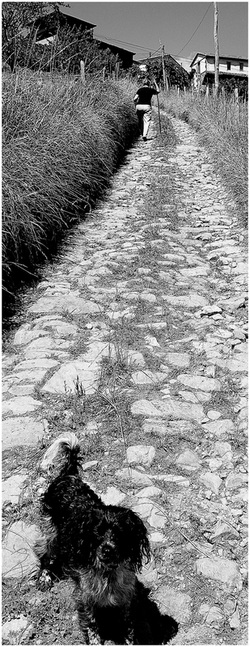I’d been thinking about writing a story about the pilgrimage to Santiago de Compostela for some time, ever since we had made a visit to Galicia and fallen in love with the place. All our Spanish friends had said that we had to visit the north of Spain, how cool it was in the summer and so green. So one July we packed up the car and drove across Spain in temperatures that threatened to reach 50° C, until we arrived at Cambados on the Rias Baxas. Everything our friends had told us about Galicia was right: the air was fresh and cool, the fields were lush and green and the coast line was spectacular. After the heat of Andalusia we were ecstatic. So we spent our first few days relaxing by the coast, eating the freshest and tastiest seafood we’d ever had and drinking copious glasses of the excellent wine from the area, Alberiño. My Protestant genes will not let me laze about enjoying myself for too long and soon I was suggesting we should move and seek out a little culture.
We drove a few miles up the coast to the famous city of Santiago de Compostela. It was 2004, the Holy Year for pilgrims to the city. People came from all over the world to pay homage at the shrine of St James, the patron saint of Spain, in the cathedral of Santiago de Compostela. The remains of his body are in the crypt under the altar in the cathedral and draw thousands of pilgrims each year. That year there were almost 180,000 pilgrims. Luckily not all of them converged on the city in July, but nevertheless Santiago was packed with weary travellers. It was impossible not to be intrigued by the spectacle and to admire the tenacity of these people, some old, some young, who had walked hundreds of kilometres along the Way of St James or, as it is known in Spanish, El Camino de Santiago, just to be there. It was also difficult not to speculate on the motives that drove people to walk across fairly difficult terrain and stay in pretty spartan accommodation for weeks on end, just so that they could have their pilgrims’ passports stamped and receive their compostela, (completion certificate) at the end of the journey. Some were obviously driven by religious reasons but not all of them. It was this speculation that led me to write SANTIAGO TALES, my twenty-first century version of The Canterbury Tales by Geoffrey Chaucer. However I did not begin to write the book until 2012, eight years later. By chance my neighbour told me about a friend of hers who had just completed the pilgrimage from Roncevalles to Santiago de Compostela in five weeks, a distance of 780 kilometres. An admirable feat by anyone’s standards, but when she told me that the woman in question was seventy-six years old, my admiration soared. She introduced me to this intrepid walker , who kindly told me about her adventures. That was when I knew I had to write my book. So thanks to her, SANTIAGO TALES was born. In it the main character, a woman in her fifties, has a particular reason for walking the Camino, the details of which are revealed on the way. On her journey she meets other pilgrims who, each in turn, in the manner of The Canterbury Tales, tell their own story.
We drove a few miles up the coast to the famous city of Santiago de Compostela. It was 2004, the Holy Year for pilgrims to the city. People came from all over the world to pay homage at the shrine of St James, the patron saint of Spain, in the cathedral of Santiago de Compostela. The remains of his body are in the crypt under the altar in the cathedral and draw thousands of pilgrims each year. That year there were almost 180,000 pilgrims. Luckily not all of them converged on the city in July, but nevertheless Santiago was packed with weary travellers. It was impossible not to be intrigued by the spectacle and to admire the tenacity of these people, some old, some young, who had walked hundreds of kilometres along the Way of St James or, as it is known in Spanish, El Camino de Santiago, just to be there. It was also difficult not to speculate on the motives that drove people to walk across fairly difficult terrain and stay in pretty spartan accommodation for weeks on end, just so that they could have their pilgrims’ passports stamped and receive their compostela, (completion certificate) at the end of the journey. Some were obviously driven by religious reasons but not all of them. It was this speculation that led me to write SANTIAGO TALES, my twenty-first century version of The Canterbury Tales by Geoffrey Chaucer. However I did not begin to write the book until 2012, eight years later. By chance my neighbour told me about a friend of hers who had just completed the pilgrimage from Roncevalles to Santiago de Compostela in five weeks, a distance of 780 kilometres. An admirable feat by anyone’s standards, but when she told me that the woman in question was seventy-six years old, my admiration soared. She introduced me to this intrepid walker , who kindly told me about her adventures. That was when I knew I had to write my book. So thanks to her, SANTIAGO TALES was born. In it the main character, a woman in her fifties, has a particular reason for walking the Camino, the details of which are revealed on the way. On her journey she meets other pilgrims who, each in turn, in the manner of The Canterbury Tales, tell their own story.
SANTIAGO TALES is due to be published later this year.


Recent Comments